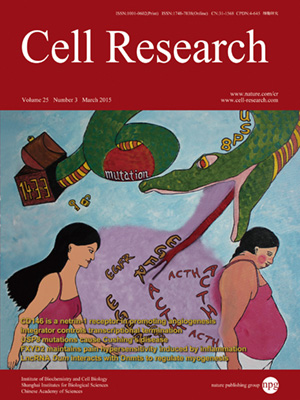Volume 25 Issue 3, March 2015: 306-317 | Open Access
ORIGINAL ARTICLES
Recurrent gain-of-function USP8 mutations in Cushing s disease
Zeng-Yi Ma1,*, Zhi-Jian Song2,*, Jian-Hua Chen2,3,*, Yong-Fei Wang1,*, Shi-Qi Li1,*, Liang-Fu Zhou1, Ying Mao1, Yi-Ming Li4, Rong-Gui Hu5, Zhao-Yun Zhang4, Hong-Ying Ye4, Ming Shen1, Xue-Fei Shou1, Zhi-Qiang Li2, Hong Peng5, Qing-Zhong Wang2, Dai-Zhan Zhou2, Xiao-Lan Qin2, Jue Ji2, Jie Zheng2, Hong Chen6, Yin Wang6, Dao-Ying Geng7, Wei-Jun Tang7, Chao-Wei Fu8, Zhi-Feng Shi1, Yi-Chao Zhang1, Zhao Ye1, Wen-Qiang He1, Qi-Lin Zhang1, Qi-Sheng Tang1, Rong Xie1, Jia-Wei Shen2, Zu-Jia Wen2, Juan Zhou2, Tao Wang9, Shan Huang9, Hui-Jia Qiu1, Ni-Dan Qiao1, Yi Zhang1, Li Pan1, Wei-Min Bao1, Ying-Chao Liu10, Chuan-Xin Huang11, Yong-Yong Shi2,12 and Yao Zhao1
1Department of Neurosurgery, Shanghai Pituitary Tumor Center, Huashan Hospital, Shanghai Medical College, Fudan University, Shanghai 200040, China
2Bio-X Institutes, Ministry of Education Key Laboratory for the Genetics of Developmental and Neuropsychiatric Disorders, Institute of Social Cognitive and Behavioral Sciences, Shanghai Jiao Tong University, Shanghai 200030, China
3Shanghai Key Laboratory of Psychotic Disorders, Shanghai Mental Health Center, Shanghai Jiao Tong University School of Medicine, Shanghai 200030, China
4Department of Endocrinology, Huashan Hospital, Shanghai Medical College, Fudan University, Shanghai 200040, China
5State Key Laboratory of Molecular Biology, Institute of Biochemistry and Cell Biology, Shanghai Institutes for Biological Sciences, Chinese Academy of Sciences, Shanghai 200031, China
6Department of Neuropathology, Huashan Hospital, Shanghai Medical College, Fudan University, Shanghai 200040, China
7Department of Radiology, Huashan Hospital, Shanghai Medical College, Fudan University, Shanghai 200040, China
8Department of Epidemiology, School of Public Health, Fudan University, Shanghai 200032, China
9Department of Neurosurgery, Shanghai 5th People's Hospital, Shanghai 200240, China
10Department of Neurosurgery, Provincial hospital, Shandong University, Jinan, Shandong 250021, China
11Shanghai Institute of Immunology & Department of Immunobiology and Microbiology, Shanghai Jiao Tong University School of Medicine, Shanghai 200025, China
12Shandong Provincial Key Laboratory of Metabolic Disease, the Affiliated Hospital of Qingdao University, Qingdao, Shandong 266003, China
Correspondence: Yong-Yong Shi, Tel/Fax: +86-21-62932151; E-mail: shiyongyong@gmail.com; Yao Zhao, Tel/Fax: +86-21-52888728; E-mail: zhaoyaohs@vip.sina.com; Chuan-Xin Huang, Tel/Fax: +86-21-52888683;(huangcx@shsmu.edu.cn)
Cushing s disease, also known as adrenocorticotropic hormone (ACTH)-secreting pituitary adenomas (PAs) that cause excess cortisol production, accounts for up to 85% of corticotrophin-dependent Cushing s syndrome cases. However, the genetic alterations in this disease are unclear. Here, we performed whole-exome sequencing of DNA derived from 12 ACTH-secreting PAs and matched blood samples, which revealed three types of somatic mutations in a candidate gene, USP8 (encoding ubiquitin-specific protease 8), exclusively in exon 14 in 8 of 12 ACTH-secreting PAs. We further evaluated somatic USP8 mutations in additional 258 PAs by Sanger sequencing. Targeted sequencing further identified a total of 17 types of USP8 variants in 67 of 108 ACTH-secreting PAs (62.04%). However, none of these mutations was detected in other types of PAs (n = 150). These mutations aggregate within the 14-3-3 binding motif of USP8 and disrupt the interaction between USP8 and 14-3-3 protein, resulting in an elevated capacity to protect EGFR from lysosomal degradation. Accordingly, PAs with mutated USP8 display a higher incidence of EGFR expression, elevated EGFR protein abundance and mRNA expression levels of POMC, which encodes the precursor of ACTH. PAs with mutated USP8 are significantly smaller in size and have higher ACTH production than wild-type PAs. In surgically resected primary USP8-mutated tumor cells, USP8 knockdown or blocking EGFR effectively attenuates ACTH secretion. Taken together, somatic gain-of-function USP8 mutations are common and contribute to ACTH overproduction in Cushing s disease. Inhibition of USP8 or EGFR is promising for treating USP8-mutated corticotrophin adenoma. Our study highlights the potentially functional mutated gene in Cushing s disease and provides insights into the therapeutics of this disease.
10.1038/cr.2015.20
FULL TEXT | PDF
Browse 2778


